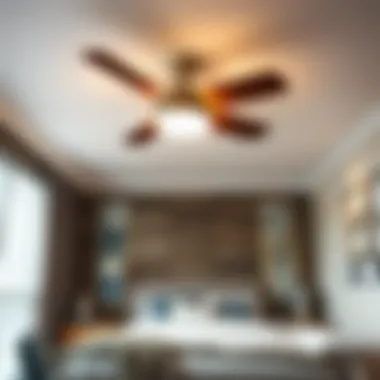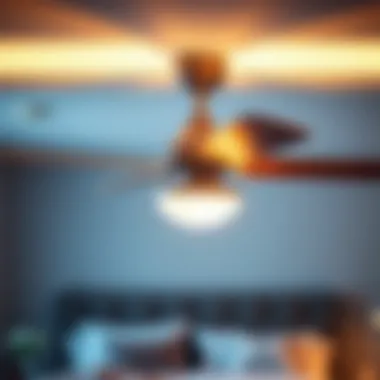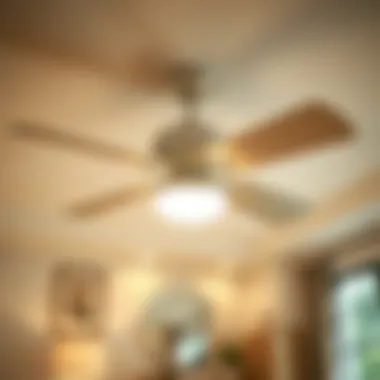Choosing the Best Ceiling Fan with Light for Small Bedrooms


Intro
Choosing the right ceiling fan with light for a small bedroom is more than just a practical choice; it's about creating an atmosphere that melds comfort with style. In compact spaces, every element must be carefully selected to ensure both functionality and aesthetic appeal. A well-designed ceiling fan can serve as a focal point while also enhancing air circulation and lighting, resulting in a cozy and stylish sanctuary.
A fan equipped with integrated lighting can save space—and it can contribute to the room's overall theme. Whether it's for a serene retreat or a lively design, the choice of fan can enhance the overall flow and longevity of your bedroom experience.
To navigate this process effectively, we will explore key aspects ranging from furniture styles and trends to practical considerations for installation and efficiency. This comprehensive guide is tailored for homeowners, designers, and DIY enthusiasts, providing the insights needed to make informed decisions.
Furniture Styles and Trends
Modern vs. Traditional: Understanding the Aesthetics
When it comes to selecting a ceiling fan for a small bedroom, considering the overall aesthetic of the space is paramount. Modern designs often boast clean lines, minimalistic features, and contemporary materials that capture the essence of sleekness. Think about fans with bladeless technology or those that blend seamless LEDs into their structure.
In contrast, traditional fans may evoke a sense of nostalgia with wood finishes, intricate detailing, and more classic shapes. They can complement a rustic or vintage decor, creating a comfortable and warm atmosphere. Here, the choice boils down to personal preference:
- Modern Fans: Usually made of metal or glass; tend to offer energy-efficient LED options.
- Traditional Fans: Often feature wooden blades, ornate designs, and a more formal appearance.
Color and Material Trends: What's In and What's Out
The colors and materials used in ceiling fans can dramatically influence a small bedroom’s ambiance. Neutral colors like white, black, or soft pastels are great choices as they merge well with various decor styles. Meanwhile, materials like wood, metal, and acrylic can either bring warmth or a modern edge, depending on the effect you want to achieve.
Recent trends lean towards:
- Brushed Nickel: A popular choice for modern fans due to its versatility and chic appearance.
- Hued Blades: Something bold yet subdued can make the fan a statement piece without overwhelming.
Sticking to a cohesive theme can help foster a more organized and pleasant environment. It's essential to keep in mind the room's existing color palette when making a selection.
"In a small space, less is often more; simplicity in design can lead to greater comfort and functionality."
Practical Considerations for Installation
Installation may vary significantly based on the fan's weight and size, as well as the ceiling height in the bedroom.
Size Matters
- Room Size: For small bedrooms, fans with a blade span of 36 inches or less work effectively without overpowering the space.
- Ceiling Height: Low-profile fans are ideal for low ceilings, while standard installations typically require an eight-foot distance from the floor for optimal airflow.
Energy Efficiency
With rising concerns about energy conservation, selecting a fan with a high Energy Star rating ensures efficiency and cost-effectiveness over time. These fans often use advanced motor technology:
- DC Motors: They consume significantly less energy compared to standard AC motors.
In all, the combination of style and practical considerations when selecting a ceiling fan contributes to a welcoming and functional bedroom environment. Taking the time to examine each aspect with clarity increases the likelihood of satisfaction with the final result.
Foreword to Ceiling Fans with Light
In small bedrooms, every square inch counts. That's why choosing the right ceiling fan with light becomes more than just a matter of comfort. It’s about optimizing space while adding functionality and style. With the right overhead fan, one can transform a cramped room into a cozy sanctuary. The decision goes beyond mere aesthetics; it involves understanding the different roles a ceiling fan plays in a room.
Understanding the Role of Ceiling Fans
Ceiling fans wear many hats. They circulate air to keep the room cool during the hotter months, which means less reliance on air conditioning and potentially lower energy bills—who doesn’t want that? They also provide desirable light, eliminating the need for bulky lamps that can crowd your floor space. Thus, the ceiling fan becomes an essential part of maintaining a comfortable atmosphere. Furthermore, they can enhance the decor, adding a touch of character to the room. A well-chosen ceiling fan harmonizes the entire space while performing its functional roles seamlessly.
When considering their function, it’s vital to account for the layout of the room, including the position of furniture. For instance, placing a fan directly above a bed can be beneficial, offering a gentle breeze while sleeping. Conversely, ensuring that a fan doesn't disrupt hanging decorations or framed pictures is equally vital. In essence, understanding how a ceiling fan will fit into the overall bedroom layout requires some thought and planning.
Benefits of Integrated Lighting
When discussing ceiling fans with integrated lighting, it’s clear that these units merge function and style. Integrated lighting means a built-in fixture that illuminates the room. This dual-purpose approach is particularly beneficial in small bedrooms where space is often at a premium.
There are numerous upsides to choosing a ceiling fan with integrated lighting:
- Space-saving: By not having separate lighting fixtures, you keep the ceiling tidy and reduce clutter.
- Efficiency: Modern ceiling fans with light use energy-efficient bulbs, which can significantly cut down electricity costs.
- Versatility: Many fans come with adjustable brightness settings, allowing homeowners to set the mood as needed—whether for cozy reading or brightening up the space during the day.
- Style variety: With an array of designs available, finding an option that complements the room’s decor becomes easier than ever.
The integration of lighting into ceiling fans combines aesthetics, functionality, and efficiency, aligned perfectly for the needs of small bedrooms.
In summary, understanding the comprehensive role of ceiling fans and the advantages of integrated lighting paves the way for making informed decisions. It’s about finding the right balance between utility and style, ensuring that a small bedroom serves both as a restful retreat and a stylish space.


Factors to Consider for Small Bedrooms
When it comes to selecting a ceiling fan with light for compact areas like small bedrooms, several factors hold significant weight. Understanding these elements is crucial for achieving an optimal balance of comfort, functionality, and design aesthetics. In small spaces, every decision can drastically affect both usability and the overall ambiance. Thus, it is essential to choose wisely.
Room Size and Ceiling Height
The dimensions of the room are arguably one of the first elements to weigh in on when choosing a ceiling fan. Smaller bedrooms usually have a narrower area for airflow, so selecting a fan that fits comfortably can make a lot of difference. An ideal way to approach this is by measuring not only the room's floor space but also the ceiling height.
For instance, a low profile fan often fits snugly in rooms with standard or lower ceilings—these fans generally don’t hang down far and support the flow of air effectively without feeling obstructive. Also, if the ceiling goes higher than 8 feet, considering a fan with a longer downrod might be beneficial.
Furthermore, keep in mind that the fan itself shouldn’t overpower the room. An overly large fan could make the room feel cramped. On the flip side, a fan that’s too small might not circulate air adequately. A good rule of thumb is to select a fan size that corresponds appropriately with the room's dimensions:
- For rooms smaller than 75 sq. ft., consider using a fan with a diameter of 36 inches or less.
- In spaces between 76 to 144 sq. ft., a fan of about 44 inches works well.
- For areas between 145 and 225 sq. ft., aim for a fan that's 52 inches in diameter.
Light Output and Brightness
Brightness is another key concern. When selecting a fan with integrated lighting, understanding how much light you need is paramount. In a small bedroom, the amount of light can make or break the setting. Too dim, and it can feel like a cave; too bright, and it can detract from intimacy and comfort.
- Lumens reflect how bright the light actually is. A range of 1,000 to 2,000 lumens usually suits a small bedroom. Check the total lumens produced, especially if the fan comes with multiple bulbs.
- Color temperature is another consideration; warmer bulbs (about 2700K-3000K) yield a cozy glow, while cooler ones (4000K and up) tend to create an energy-zapping environment.
Another plus is the flexibility in lighting types such as pendant lights or integrated LED panels, different light styles can also change how spacious your bedroom appears. For example, a flush mount fixture can provide focused light while reducing shadows, thus broadening the visual space.
Design Preferences and Aesthetics
Finally, aesthetics can’t be sidelined. The design of your ceiling fan impacts the room’s character. A small bedroom shouldn't feel cluttered by a visually overwhelming fan. Instead, the selected design should complement existing decor. Here are ways design can enhance your room:
- Finishes: Whether you prefer sleek metallic finishes or warm wooden textures, choose a look that meshes with your bedroom's overall style.
- Style: Traditional designs offer elegance, while modern models often scream contemporary chic. Hybrid designs may also exist that mix both styles seamlessly.
- Blade count: A fan with fewer blades tends to circulate air faster, while fans with more blades can provide more aesthetic appeal but may move air slower.
In sum, when selecting a ceiling fan for a small bedroom, it’s a trifecta of room size, light output, and design aesthetics that should guide your choices. Each of these factors forms a cohesive whole that fosters comfort, efficiency and sets the mood in your restful space. Remember, a well-thought-out fan can tie the whole room together, creating an oasis of calm from the hustle and bustle outside.
Types of Ceiling Fans with Light
Selecting the right types of ceiling fans with light is crucial for anyone looking to enhance their small bedroom. The variety encompasses a broad spectrum of designs, functionalities, and features, catering to diverse tastes and requirements. When choosing, it’s not just about creating a particular aesthetic; it’s about enhancing the room’s atmosphere and optimizing light distribution. Here are the main types:
Traditional Ceiling Fans
Traditional ceiling fans exude warmth and familiarity. They come in wood or metal finishes, often adorned with intricate designs, reflecting classic craftsmanship. For a small bedroom, these fans can provide a cozy touch, complementing rustic or vintage decor. They tend to be more robust, which adds to their longevity.
- Pros:
- Cons:
- Timeless appeal
- Variety in materials and styles
- Often equipped with energy-efficient options
- Can take up more visual space
- Some models might be noisy
Modern and Contemporary Designs
If a minimalist aesthetic resonates with you, modern ceiling fans with light might be the answer. These fans often feature sleek lines, metal finishes, and cutting-edge technology. They are especially effective in tight spaces, where their streamlined look can make a small room feel open and airy.
- Stylish Appeal: Modern designs often incorporate unique shapes, such as blades that appear to float.
- Functionality: Many modern fans come with built-in LED lights, giving you energy efficiency alongside style.
Flush Mount Fans
Flush mount fans are a lifesaver for small bedrooms with low ceilings. They sit snugly against the ceiling, eliminating any concern about headroom. These fans come in various designs, from classic to ultramodern, making it easy to find one that fits snugly in your decor scheme.
- Ideal for Low Ceilings: By reducing the clearance needed, they make even the tightest spaces usable.
- Light Distribution: Since they are close to the ceiling, they can distribute light evenly throughout the room.
Remote-Controlled Options
Ah, the luxury of convenience! Remote-controlled fans allow you to adjust speed, direction, and lighting without leaving your cozy nest. This can be especially beneficial in smaller spaces, where you might not want to reach up and fiddle with the controls.
- User-friendly: One can easily adjust the settings without moving from the bed.
- Versatile options: Many of these fans have numerous settings, letting you customize airflow and ambiance depending on the time of day.
In summary, each type has its unique appeal and suitability based on personal taste, space limitations, and intended use. When contemplating the best fit for your small bedroom, consider the functionality and style that resonate with your aesthetic vision.
Energy Efficiency Considerations
When selecting a ceiling fan with light for small bedrooms, energy efficiency plays a pivotal role that cannot be ignored. Not only do energy-efficient models contribute to reducing your overall utility bills, they also promote sustainable living practices that benefit the environment. Opting for energy-efficient ceiling fans means you are making a smart choice that can help in lowering greenhouse gas emissions while maintaining a comfortable atmosphere in your home.


Understanding Energy Star Ratings
Energy Star ratings are a straightforward way to gauge a product's energy efficiency. These ratings are assigned to appliances, including ceiling fans, that meet specific energy-saving guidelines set by the U.S. Environmental Protection Agency. Investing in a ceiling fan that boasts an Energy Star label means you’re likely to save money in the long run. For example, Energy Star-rated fans consume less energy during operation while still delivering effective performance. With the correct installation and usage, some fans can reduce energy consumption by up to 60% compared to standard models.
"Energy-efficient ceiling fans can be a long-term investment, not just in comfort, but in savings."
There are several components to take into account when evaluating the efficiency of potential models. For instance, the motor technology—DC motors are generally more efficient than their AC counterparts. Additionally, blade design affects airflow efficiency and comfort. Meaning, choosing the right fan with the right specifications allows you to enjoy your space more comfortably without feeling the pinch on your energy bill.
LED Lighting Benefits
Pairing your ceiling fan with LED lighting also maximizes energy efficiency. Unlike traditional incandescent bulbs, LED lights use significantly less power and have a much longer lifespan. An LED bulb consumes about 75% less energy than an incandescent bulb and can last up to 25 times longer. This means not only lower electric bills but also fewer trips to the store to replace bulbs.
Moreover, many new ceiling fans are designed with integrated LED lighting, providing both illumination and air circulation without needing additional fixtures. This simplifies your lighting setup while ensuring you are not compromising on brightness or quality. By selecting LED-equipped fans, you also ensure that you’re contributing to less waste, as fewer dead bulbs end up in landfills each year.
In summary, prioritizing energy efficiency when it comes to ceiling fans with lights is crucial. Be it through understanding Energy Star ratings or opting for LED lighting, your choices can lead to significant benefits now and in the future, making your small bedroom more comfortable while being kind to both your wallet and the planet.
Installation Guidelines
When it comes to choosing a ceiling fan with light for a small bedroom, installation guidelines are essential. A well-installed ceiling fan not only enhances comfort but also integrates seamlessly into your room’s aesthetic. Improper installation can lead to performance issues, noise, or even safety hazards. Thus, it’s vital to follow proper procedures and consider certain factors before setting up your ceiling fan.
Preparation and Planning
Installing a ceiling fan involves more than just picking a spot on the ceiling. Before you even take the fan out of the box, there’s a bit of groundwork to lay.
- Gather Necessary Tools: Ensure you have all required tools at hand, such as a screwdriver, wire stripper, and a ladder. Being well-equipped helps streamline the installation process and cuts down on unwanted delays.
- Assess Electrical Capacity: Check your home’s electrical system to confirm it can support the fan. A standard ceiling fan typically needs a dedicated circuit or, at the very least, should be on a circuit that isn’t overloaded.
- Determine Ideal Location: Consider the fan’s placement carefully. It shouldn’t be too close to the wall—allowing at least 18 inches—and it’s advisable to keep it at least 7 feet above the floor for optimal airflow.
- Consult the Manufacturer’s Instructions: Every fan might have slightly different specifics for installation. Read through the manual to familiarize yourself with what to expect and what tools you’ll need.
Preparing adequately ensures a smoother installation process and helps minimize potential problems down the road.
Hiring a Professional vs. DIY
Many homeowners ponder whether to tackle fan installation themselves or hire a professional. Here are some considerations regarding these two approaches:
DIY Installation:
- Cost-Effective: Going the DIY route can save money on labor costs, which is appealing if you’re on a tight budget.
- Sense of Accomplishment: Completing the job on your own can give a gratifying feeling of achievement.
- Availability of Resources: Many video tutorials and guides exist online, making it relatively easy to follow step-by-step processes.
However, DIY might not be for everyone.
- Complexity: If you aren’t comfortable working with electricity, you risk damaging the fan or causing safety hazards. Not to mention, a poorly installed fan can lead to noise or even cause it to fall.
Hiring a Professional:
- Expertise: Professionals bring valuable experience. They can spot potential issues before they arise and handle tricky parts of the installation efficiently.
- Safety: When dealing with electricity, ensuring everything is done safely is paramount. Professionals follow all safety codes and regulations, minimizing risks.
- Satisfaction Guarantee: Many professionals offer warranties for their work, which provides peace of mind. You won’t have to worry about the fan’s performance afterward.
Maintenance and Care
Taking care of your ceiling fan with light is one of those tasks that can easily slip your mind, much like watering those pesky houseplants. Yet, regular maintenance is crucial to keep it operating efficiently and prolong its life. Small bedrooms, often cozy, can collect dust pretty quickly. If left unattended, this dust may affect the fan’s performance and even its appearance. Plus, nobody wants to sleep under a layer of grime, do they? Keeping your ceiling fan well-maintained can enhance both functionality and aesthetics, making it an integral part of your small bedroom’s charm.
Cleaning and Dusting Tips
Keeping your ceiling fan spick and span isn't rocket science, but there are some best practices you can follow. Here’s a friendly rundown of cleaning and dusting tips:
- Turn Off the Power: Safety first! Always ensure the fan is turned off before starting any cleaning.
- Use a Dusting Cloth or Duster: A microfiber cloth works wonders. Wrap your cloth around a broom handle if you can’t reach those higher blades. Don’t forget to give it a good wipe-down.
- Routine Cleaning: Aim to do this every month. A regular dusting can prevent buildup that’s much harder to tackle later on.
- Deep Cleaning: For a more thorough clean, consider removing the fan blades when possible. Wash them in warm, soapy water, then overnight it to dry fully before reinstalling.
- Taking Care of Light Fixtures: If your fan includes lights, be sure to clean them as well. Dusty bulbs lower brightness levels and can give an overall dingy look to your space.
These tips can make a world of difference. By keeping your ceiling fan cleaned regularly, you’ll not only improve air circulation but ensure it remains a stunning feature in your bedroom.
Identifying Common Issues
Just like with any household appliance, ceiling fans are not immune to issues. Understanding what common problems may arise can save you both time and money in the long run. Here are a few typical issues and how to spot them:
- Noisy Operation: If your ceiling fan clinks or rattles, it may mean that it's not installed securely. Sometimes, a simple tightening of screws can do the trick. However, if it continues, check for any cracks in the blades or parts.
- Slow or Weak Airflow: If it feels like your fan is just going through the motions, it may require dusting or might need a more serious inspection of the motor.
- Light Flickering: This could indicate a problem with the wiring or the lightbulb. Ensure the bulbs are screwed in tightly, and if flickering continues, consider consulting a professional.
- Hanging Loosely: If the fan seems to wobble, it's not just uncomfortable to look at—it can be dangerous. This issue often results from improper installation or a need for rebalancing.
Addressing these issues promptly is key. Not only can it maintain the functionality of the fan, but it also ensures a safer environment. Don't forget to refer to your user manual for any specific guidance the manufacturer may provide!
By attuning your focus to proper maintenance and being diligent in addressing any signs of trouble, you'll keep your ceiling fan in tip-top shape, ultimately enhancing the comfort of your small bedroom.
Popular Brands and Models


When it comes to selecting a ceiling fan with light for a small bedroom, navigating through various brands and models can feel a bit like finding a needle in a haystack. Still, understanding the significance of well-known brands can make the process smoother. Popular brands often bring a level of reliability and assurance, which can be especially important for those who might not have much experience with home improvement projects.
These brands typically offer components that are both durable and efficient. For instance, opting for a recognized manufacturer can greatly reduce the risk of quality issues. Additionally, these brands tend to offer better customer service and warranties, ensuring that if something does go awry, assistance is readily available. Thus, it’s not just about finding a fan; it’s also about aligning oneself with a manufacturer that provides trustworthiness and support.
Budget-friendly Options
For many, price is a critical factor. Luckily, the market has an array of budget-friendly options that don’t skimp on quality. Brands like Harbor Breeze and Westinghouse offer ceiling fans at a lower price point while still delivering functionality and design.
When shopping for these options, it’s best to look at features like energy efficiency and light output since you want both aesthetics and performance. Additionally, checking customer reviews can provide insights into the durability and effectiveness of specific models. Remember, a good budget-friendly option should not just be cheap; it should balance value with quality.
Premium Choices
On the flip side, if you’re willing to splurge a bit, premium brands like Hunter or Minka-Aire deliver some stunning options. Premium ceiling fans often feature advanced technology for quiet operation and high performance. Moreover, they usually incorporate innovative designs and materials, making them a focal point of your room. These brands often invest in sophisticated design, so they not only serve the purpose of air circulation and lighting but also act as a statement piece that can enhance the overall aesthetic of your bedroom.
However, it’s essential to evaluate the additional features that come with these pricier models—remote control operation, dimmable lights, and smart home compatibility can all add value to your purchase. As such, it’s wise to assess whether the added functionalities implicitly justify the cost.
Sustainable Brands
As more individuals become conscious of their environmental footprint, sustainable brands have gained traction. Noteworthy mentions in this category include Big Ass Fans and Fanimation, which emphasize energy savings and eco-friendly materials. These brands often use LED lighting and energy-efficient motors to keep energy consumption at a minimum.
Incorporating a sustainable ceiling fan not only benefits your wallet in the long run due to lower energy bills, but it also aligns with a commitment to environmental stewardship. When exploring these brands, it’s prudent to check their sustainability certifications, as these can provide a reliable benchmark for their claims regarding eco-friendliness.
Purchasing from sustainable brands ultimately promotes responsible consumerism, influencing positive changes in climate impact.
Whether one is leaning towards budget-friendly options, considering premium models, or keen on sustainable choices, understanding the intricate offerings of each brand is crucial. It’s about making an informed decision that ultimately enhances both the functionality and aesthetic appeal of your small bedroom.
Enhancing Bedroom Design
In the quest for the perfect small bedroom, enhancing its design transcends mere aesthetics; it’s about creating an inviting and functional space. A well-chosen ceiling fan with a light not only serves as a cooling mechanism but also can become a centerpiece of decor. This section delves into the intricacies of incorporating ceiling fans into the broader design of your bedroom, exploring how they complement existing decor and contribute to a harmonious atmosphere.
Incorporating Ceiling Fans in Decor
Ceiling fans come in various styles, which can be a boon when you're trying to establish a particular look in your small bedroom. Whether your style leans towards traditional elegance or modern chic, there’s a fan to match. Here’s how to effectively incorporate them:
- Style Match: Choose a fan that aligns with your existing furniture and color scheme. A rustic wooden fan might beautifully contrast with sleek, modern furniture, while a minimalist design may enhance a contemporary aesthetic.
- Scale Matters: Given the limited size of a small bedroom, opt for fans that don't overpower the space. A compact and low-profile fan can make the ceiling feel taller and the room feel more open.
- Color Coordination: Select colors that either blend in or provide a pop of contrast. White or light-colored fans can seamlessly integrate into bright rooms, whereas bold colors or metallics can act as striking focal points.
As you ponder your options, remember to factor in the ceiling height. A low-profile ceiling fan is ideal for rooms with standard or lower ceilings, ensuring optimal airflow without creating a cramped atmosphere.
Complementing Other Lighting Elements
Integrating a ceiling fan with light into your bedroom design also involves thoughtful coordination with other lighting sources. Here’s how it can be done:
- Layered Lighting: Utilize a combination of ambient, task, and accent lighting. A ceiling fan with integrated lighting can serve as the primary ambient light source, while bedside lamps offer task lighting for reading. This layered approach fosters a cozy atmosphere.
- Dimming Features: Opt for fans with adjustable lighting. Having the ability to dim the lights can transform the room from bright and energetic during the day to soft and soothing at night. This flexibility is particularly crucial in a small bedroom, where the mood can dramatically change the perception of space.
- Placement and Design: Consider the placement of other light fixtures in the room. Ensure they don’t compete with your fan but rather work in harmony. Wall sconces or pendant lights should complement the fan, maintaining a flow throughout the room.
A well-coordinated lighting scheme can change how a small space feels—making it appear larger and more inviting.
By thoughtfully incorporating ceiling fans into your bedroom design, you elevate not just functionality but also style. A carefully chosen ceiling fan can unify the elements of your room, contributing to an inviting atmosphere that speaks to both comfort and beauty.
Remember, every choice counts, from the fan's design to its color and light output. Your bedroom isn’t just a place to sleep; it's a personal sanctuary.
For further reading on how lighting can affect interior design, you may refer to Wikipedia or explore more on Britannica.
The thoughtful approach to selecting and incorporating a ceiling fan with light can enhance your small bedroom significantly, making it a stylish oasis that reflects your taste and meets your needs.
Finale
When it comes to selecting a ceiling fan with light for a small bedroom, understanding the intersections of functionality, design, and efficiency is crucial. In this article, we’ve carefully navigated through the pivotal aspects every homeowner or designer should ponder over. An ideal ceiling fan isn’t just a fixture; it’s a tool that contributes significantly to the ambiance and utility of a living space.
Recap of Key Considerations
Choosing the right ceiling fan with light requires careful deliberation on several fronts:
- Room Size and Ceiling Height: Know the dimensions of your space; this will dictate whether you opt for flush mounts or more standard fans. A light design can draw the eye upward, creating the illusion of greater height.
- Light Output and Brightness: Lighting should be both functional and cozy. Opt for adjustable brightness settings, as they provide versatility depending on the time of day or the activity at hand.
- Energy Efficiency: Pay attention to the energy ratings; those fans with better ratings will save you money on utility bills in the long haul. LED bulbs paired with energy-efficient motors serve both aesthetic and environmental purposes.
- Style and Aesthetics: The design should blend seamlessly with the bedroom decor. Whether leaning towards sleek contemporary styles or classic looks, ensuring harmony can elevate the entire room.
Making an Informed Choice
Finally, informed decision-making comes into play. After weighing all these factors, it’s important to consider more personal elements such as your budget and long-term vision for the space.
- Make a checklist of priorities; start with must-haves, then filter down to what would be nice to have.
- Engage with customer reviews and brand reputations; real-life experiences can reveal common pitfalls or standout features not highlighted in product descriptions.
- Don’t overlook the installation aspect—whether you decide to go DIY or hire a professional, ensure that the installation aligns with your preferences and capabilities.
"Choosing the right ceiling fan can mean the difference between a restful sleep and a restless night. Make it count."
Incorporating all these considerations not only streamlines the selection process but also makes room for a ceiling fan that is more than just a decoration; it’s a functional part of your small bedroom that enhances both comfort and warmth.















